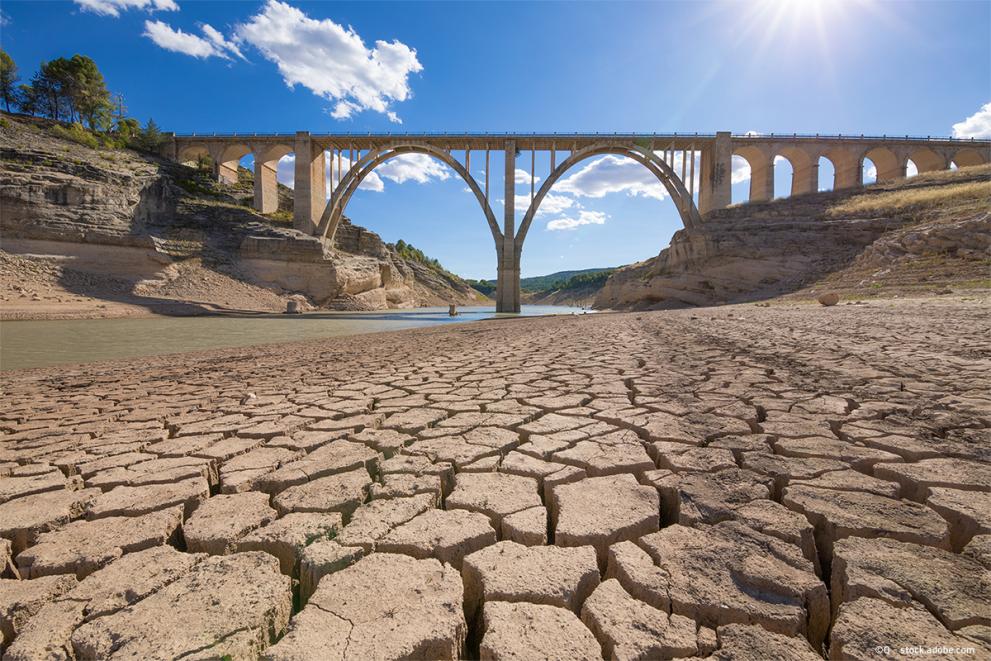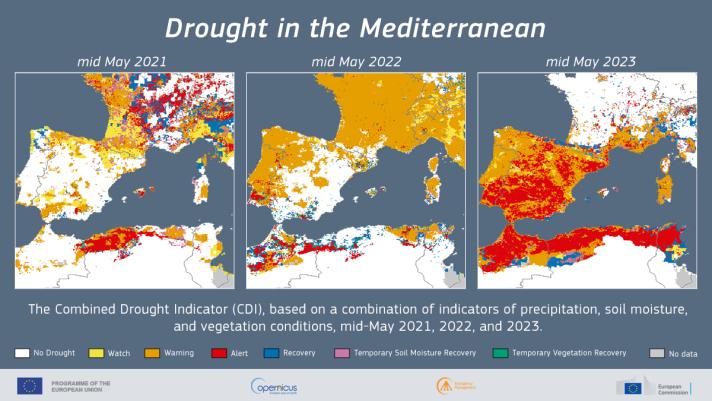
A severe drought has been affecting the western Mediterranean, reducing soil moisture and river flows, and stunting plants and crops during their crucial growing season. A new report on drought in the western Mediterranean from the JRC’s Copernicus Global Drought Observatory reveals the extent of the water shortage hitting the region.
Heatwaves and low rainfall lead to worsening drought levels
Many parts of the western Mediterranean have seen persistently low rainfall for more than a year. This, combined with an exceptionally dry and warm late winter and spring, has caused severe drought in the region, and temperatures can be expected to rise further in the summer.
Between May 2022 and April 2023, temperatures in northern Morocco, Algeria, southern Spain, southern France and northern Italy were up to 2.5°C - sometimes 4°C – higher than average. Long-lasting and intense heatwaves contributed to these records.
The conditions in late spring 2023 were worse than those of 2022, when a severe-to-extreme drought developed over Europe affecting water resources, agriculture and energy production.
In addition, the JRC’s indicators point to widespread low river flows caused by the lack of rainfall. Spain is experiencing water shortages, particularly in Andalusia where water reservoirs are at about 25% of their capacity.
Most of the western Mediterranean is now under warning and alert conditions (the two most severe levels) according to the combined drought indicator, which integrates data on rainfall, soil moisture and vegetation stress anomalies to map drought hazards. Identifying the drought level in this way plays an important role in helping to manage and monitor water resources in both the short and long term.
Drought in May leads to low yield forecasts
The lack of water has significantly affected vegetation and crops in the middle of the growing season, leading to delayed sowing and low yield forecasts. Severe vegetation stress (for example failed crops and smaller fruits) was recorded across the Iberian Peninsula (except for northern Portugal), northern Africa, and central-southern France.
Yield forecasts in the Maghreb have worsened further and are well below average levels. Crops are likely not to flower in Morocco, Algeria and Tunisia. In the Iberian Peninsula, drought conditions intensified and yield forecasts are well below 2022 values, with areas sown with summer crops substantially reduced. According to sources cited in the report, cereal production and livestock are the most affected sectors in Portugal.
While the Maghreb and the Iberian Peninsula are facing one of the worst seasonal droughts in recent decades, the improved crop growing conditions caused by rainfall in the Balkans, Italy, France and Türkiye may partially counterbalance the poor outlook of western Mediterranean countries. This is the finding of the Mediterranean Agricultural Market Network outlook developed by the Mediterranean Agricultural Market Network (MED-Amin) in collaboration with the JRC and released on 31 May.
The response to these yield outlooks in drought conditions depends partly on sustainable soil management, given its crucial role in the water cycle. This summer, the Commission will adopt a proposal for a Soil Law aimed at ensuring all soil ecosystems will be in a healthy condition by 2050.
Drier days ahead
The report on Drought in the western Mediterranean finds, based on the present drought situation and predictions, that if widespread warmer-than-averages temperatures and the lack of rain continue, the situation could become more critical still.
The JRC scientists also note that next summer currently has a high risk of water resources reaching a critical state, making it important to closely monitor the situation and plan and implement water management and drought adaptation measures in the region.
Explore the data
Check out the European Drought Observatory’s drought dashboard for Europe for data that you can use and adapt. The JRC has also just made available a new, more responsive and interactive, web mapping portal for users to access and visualise drought data. These data are based on our new drought detection and tracking tool.
Sources
Details
- Publication date
- 13 June 2023
- Author
- Joint Research Centre





